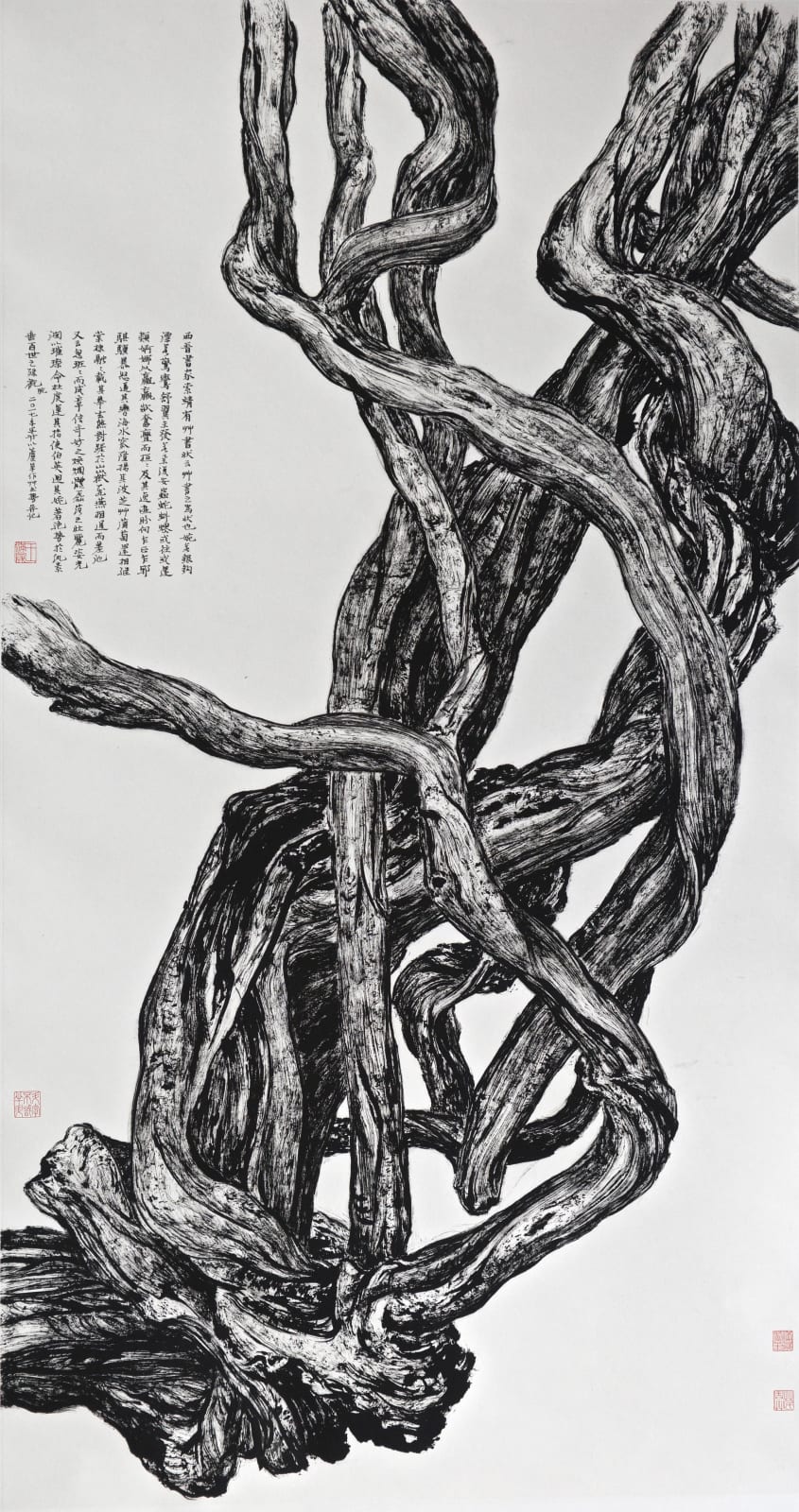-
作品

Wang Mansheng Chinese American, 1962
Ancient Vine Calligraphy 古藤, 2017Ink on paper, mounted for framing 水墨紙本 鏡片71 x 38 1/2 in
180.3 x 97.8 cmCopyright The Artist釋文: 西晉書家索靖有《艸書狀》,云「艸書之為狀也,婉若銀鈎,漂若驚鸞,舒翼未發,若舉複安。蟲蛇虯蟉,或往或還,類婀娜以羸羸,歘奮舋而桓桓。及其逸遊盼向,乍正乍邪,骐骥暴怒逼其辔,海水窊隆揚其波,芝艸蒲萄還相繼,棠棣融融載其華。玄熊對踞于山嶽,飛燕相追而差池。」又云「忽班班而成章,信奇妙之煥爛。體磊落之壯麗,姿光潤以璀璨。命杜度運其指,使伯英迴其(婉)腕。著絕勢於纨素,垂百世之殊觀。 款識:二〇一七年,半升以蘆葦作艸書勢並記。 鈐印:「「滿晟蘆筆」、「王満晟」、「艸民弄艸」、「斗字不識半升」 Artist inscription: The West Jin dynasty calligrapher Suo Jing (239-303) wrote On the Nature of Cursive Script (Cǎoshū Zhuàng), in which he described: ' Cursive script...釋文:西晉書家索靖有《艸書狀》,云「艸書之為狀也,婉若銀鈎,漂若驚鸞,舒翼未發,若舉複安。蟲蛇虯蟉,或往或還,類婀娜以羸羸,歘奮舋而桓桓。及其逸遊盼向,乍正乍邪,骐骥暴怒逼其辔,海水窊隆揚其波,芝艸蒲萄還相繼,棠棣融融載其華。玄熊對踞于山嶽,飛燕相追而差池。」又云「忽班班而成章,信奇妙之煥爛。體磊落之壯麗,姿光潤以璀璨。命杜度運其指,使伯英迴其(婉)腕。著絕勢於纨素,垂百世之殊觀。
款識:二〇一七年,半升以蘆葦作艸書勢並記。
鈐印:「「滿晟蘆筆」、「王満晟」、「艸民弄艸」、「斗字不識半升」
Artist inscription:
The West Jin dynasty calligrapher Suo Jing (239-303) wrote On the Nature of Cursive Script (Cǎoshū Zhuàng), in which he described: "
Cursive script embodies a form both graceful and dynamic: gentle as silver hooks, ethereal as startled phoenixes, wings half-unfurled—hovering between ascent and stillness. Its strokes coil like serpents or dragons, advancing and retreating, alternately sinuous in slender elegance or erupting with indomitable vigor. In its unbound flow, the brush shifts unpredictably—now disciplined, now wild—mirroring a galloping steed straining against reins, or ocean tides surging and receding. Vines intertwine like sweetgrass and grapes, blossoms glow like flowering cherry plums. Dark bears face off atop mountains, while swallows streak across the sky in staggered pursuit."He further wrote: "
Sudden patterns crystallize into luminous harmony, revealing the script’s radiant wonder. Its structure marries bold magnificence with luminous refinement—an immortal brilliance. When Du Du (active 1st century) guides the brush with mastery and Zhang Zhi (the Sage of Cursive Script, ?-192) twists his wrist to dance with ink, their transcendent artistry is captured on silk, leaving visionary marvels for generations to revere."
In the year 2017, Ban Sheng harnessed reeds to manifest the vital momentum of cursive script, hereby recording its essence.
Note:
Wang Mansheng’s artistic practice is deeply rooted in the exploration and innovation of natural materials. Through the use of self-made brushes and inks—including black walnut ink and wild reed brushes—he not only depicts the diversity of ecosystems but also redefines the interaction between painter and medium. By combining his research on ancient vine-like plants with calligraphy, Wang employs reed brushes and ink on xuan paper to capture the twisted forms, cracks, moss, and knots of vines, while imbuing them with the structure, cadence, and rhythm of calligraphy.In his works, Wang transforms the lines and textures of the natural world into a visual language on paper, showcasing both the weathered vitality of plants and the expressive gestures of calligraphy. Maintaining a traditional spirit while introducing a contemporary aesthetic perspective, he achieves a transition from physical objects to conceptual imagery. This endeavor is not only a technical exploration but also a profound reflection on the synthesis of nature and humanity.
在《古藤》系列中,王满晟将古藤类植物的自然形态与书法艺术巧妙融合,发现古藤的圆润线条宛如篆书的中锋用笔,而其绵延缠绕的姿态则似狂草的奔放笔势。通过自制的芦苇笔与水墨宣纸,他不仅精准捕捉了藤树的扭曲、干裂与结瘤,更将这些自然肌理赋予书法的结构与韵律感。这种创作方式既展现了植物蓬勃的生命力,也折射出他在自然与艺术之间寻找平衡的独特视角,让观者在每一笔触中感受到自然与人文的交融之美。
展览
2025 Mar 13 - May 3, "Fluid Strength: The Art of Ink", Fu Qiumeng Fine Art, New York, NY
订阅邮件
* denotes required fields
We will process the personal data you have supplied to communicate with you in accordance with our Privacy Policy. You can unsubscribe or change your preferences at any time by clicking the link in our emails.

